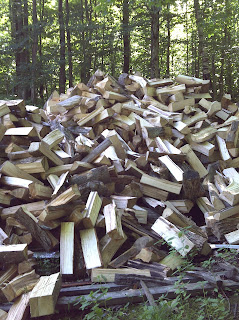 |
| Dumped here by awesome wood guy. "Here" is just below main driveway. |
These stacks are located in various spots around the house, either at the same altitude or just below. They consist of, from bottom to top:
- A wooden support platform. That's usually old planks, pallets, or scrap, sometimes elevated by bits of wood or stone. (In this post's photo you can make out two long, old 2x4s, running horizontally along the bottom.)
- Stacks of cut wood. No higher than the children's heads.
- Coverings: tarps or plywood or sheet metal, or a combination. Weighted down with rocks, after the past two winter's high winds.
These small walls of wood sit outside all year long, on average, drying slowly and steadily. In summer we haul in a stack to really dry out in the basement, ready to burn once winter makes its presence known.
So caring for this precious supply - buying or cutting wood, stacking it, protecting it from weather - is a yearlong thing. The stacks are part of our homestead landscape, at their largest looking like fortifications. This work is a homestead chore, derided but glumly performed by the children. I (Bryan) associate each spot with podcasts, as I listen to mp3s for (professional) work as I (do homestead) work. The longest rows, for example, are linked forever with episodes of the very fine Digital Campus.
The total amount of wood is very large, around 12-14 cords by October. This is a form of prudence. If we go on to experience a ferocious, drawn-out winter, one far worse than the norm, we're amply supplied. If winter turns out to be less dire, the stacks which remain come May will stand until the following winter, seasoning well.
4 comments:
Wow Bryan,
What a wonderful picture your words paint. My husband and I supplement our heat (here in the Appalachian foothills in S.C....with winters not near the severity of yours)...with our fireplace complete with a recirculating grate. Even in the coldest months, we use the fireplace in the den/center of our home as our main heat source...practically turning off other heat in the house except for when we first rise in the morning. Your description of wood stacking conjured similar work here, although my husband and I do it all now that both children are out and gone. We are overseen by the big yellow dog in our yard who is protected by the wood stacks. Times like we have experienced lately with 100 degree afternoons make those stacks seem only distantly important...but we know that soon enough we will be pulling back the tarp to dig in and warm our toes! Thanks for sharing your wood story!
Cindy Jennings
(aka @cljennings)
That's a lot! I'm trying decide whether to buy 3 or 4 cords!
But wood is only supplemental to us, when we're home all day on a weekend mainly, also some other evenings.
The last little textile mill in my town was using a thousand cords a year as late as the 1960s to power its boilers (for heat and mechanical power). Can you imagine?
Check out this photo. Yes, I think that's all firewood:
http://www.shakers.org/images/stories/galleries/buildings_cowbarn/CowBarn_66_p48.jpg
ca. 1900. Shaker village in Canterbury NH.
Another attempt at a link
Post a Comment